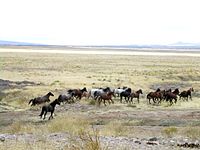
Photo from wikipedia
The startle response can be defined as a reflexive reaction to the sudden appearance of a novel stimulus that influences the survival and resilience of animals. In domesticated species, the… Click to show full abstract
The startle response can be defined as a reflexive reaction to the sudden appearance of a novel stimulus that influences the survival and resilience of animals. In domesticated species, the behavioral component of the startle response can, in some cases, cause serious injury to the animal or human handlers if inappropriately expressed. Here, we describe a longitudinal study in a population of stock-type horses that quantified behavioral startle responses elicited by the presentation of a sudden novel object (rapidly opening umbrella). The study was performed in weanling foals across four consecutive years (n = 74, mean age = 256 days). Behavioral assays for the startle response phenotype focused on six behavioral variables: latency to return to the feed pan (seconds), maximum distance fled (meters), proportion of time spent walking or trotting (seconds), and how long a horse spent standing facing away from or toward the novel object. We observed behavioral startle response variables in relation to cardiac response, age, and sex for each individual. Each horse’s cardiac startle response pattern was determined and categorized into heart rate response cluster groups identified as accelerators and decelerators. Using principal component analysis (PCA) with a factor rotation, we identified “startle response” phenotypes that summarize the behavioral and physiological variables. The largest component of variation, Factor 1, comprised 32.5% of the behavioral variable with a positive correlation with latency and distance, and was not influenced by sex or age. Factor 2 comprised 23.2% of the variation, and was positively correlated with activity level performed such as proportion of time spent walking and/or trotting. Horses with the accelerator type cardiac response had significantly higher Factor 1 scores than decelerators but did not differ in Factor 2. Future work includes expanding our sample size to conduct a genome-wide association study (GWAS) to identify novel genetic loci influencing behavioral startle reactions using recorded behavioral and physiological phenotypes.
Journal Title: Genes
Year Published: 2023
Link to full text (if available)
Share on Social Media: Sign Up to like & get
recommendations!